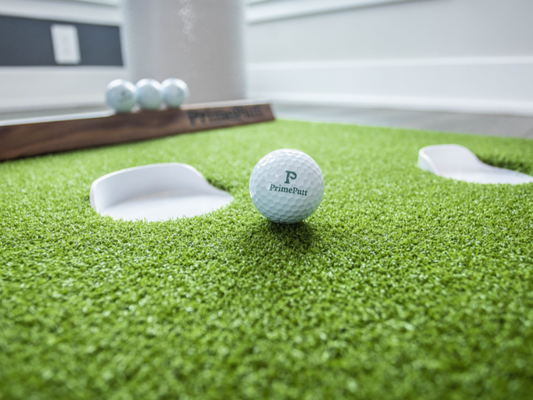You're browsing for putting mats online and land on PrimePutt's website — $490. Your jaw drops. "Four hundred and ninety dollars? For a putting mat?"
I had that same initial reaction. After thirty years of buying disappointing practice equipment, I've wasted enough money to fund a small country club membership. But let me tell you: this thing actually works.
The real question isn't why PrimePutt costs more. It's why other putting mats cost so little, and what corners they're cutting to hit that price point.
You're Buying Engineering, Not Just Carpet

Most putting mats are glorified carpet. They slap some green fabric on foam padding and call it a day. PrimePutt took a completely different approach.
They hired turf scientists. Materials engineers. People who understand why a golf ball behaves differently on bent grass versus Bermuda, why green speeds vary with moisture content, and why grain direction affects ball roll. Then they spent years reverse-engineering those exact physics into an artificial surface.
The nylon turf system they developed maintains the precise density, height, and resistance of championship greens. Not close to it. Not similar to it. The exact same Stimpmeter rating of 9-11 that you're likely to find at your nice local and private courses.
This wasn't a weekend project. This was years of prototyping, testing, and refinement to solve a problem that has frustrated golfers for decades.
Materials Cost Money (But They're Worth It)

I've owned putting mats that started curling at the edges after two weeks. Mats where the surface developed dead spots. Mats where the "green" was actually just dyed carpet that felt nothing like real grass.
PrimePutt uses half-inch nylon turf that costs more than most entire putting mats. Tour-grade material designed for daily punishment while maintaining consistent performance. The roll-flat technology means it lies perfectly flat without tape, weights, or the usual gymnastics required to keep cheap mats from bunching up.
The rubber backing provides stability without bulk. The no-memory material rolls out smoothly every time, even after months in storage. These aren't marketing features – they're engineering solutions to real problems.
A Cup Design That Exposes What's Wrong with Most Putting Mats

Here's where PrimePutt really shows its sophistication. Most putting mat cups are jokes. They either reject good putts or accept terrible ones. There's no consistency, no honest feedback about stroke quality.
PrimePutt's cup system replicates a full-depth golf hole perfectly. The ramp design moves made putts to the back, keeping the front clear for your next attempt. Makes go in, misses don't. Period.
When your practice equipment gives you brutal honesty about your stroke quality, you develop skills that transfer directly to course performance. No more wondering if that putt would have dropped on a real green.
Cheap Mats Are Expensive in the Long Run

I bought a $150 putting mat three years ago. It developed wrinkles after a month. Dead spots after three months. By six months, practicing on it was actively hurting my putting because I was compensating for surface irregularities.
$150 wasted. Plus, the time wasted practicing on garbage. Plus, the bad habits I developed. The true cost of that "bargain" was way higher than $150 I spent.
PrimePutt mats don't degrade. The surface doesn't develop inconsistencies. The roll quality doesn't change. After regular daily use, mine performs exactly like it did on day one. The cost of PrimePutt is actually lower than constantly replacing cheaper mats.
The Pros Use This Stuff for a Reason

When MyGolfSpy names PrimePutt the best indoor putting green, that's not a paid promotion. They tested dozens of products. When NBC GolfPass includes it in their top 10 golf equipment list, they're not doing PrimePutt any favors. When Breaking Eighty calls it "the Rolls-Royce of putting mats," they're telling you something important. When Golf Monthly deems PrimePutt the mat with "the best premium materials," you should take note.
Time: The Hidden Tax of Inferior Equipment

Cheap putting mats carry a hidden tax: wasted time. Every hour you spend on equipment that doesn't replicate real course conditions is an hour that doesn't contribute to actual improvement. Every stroke you take on a surface that behaves differently than real grass is potentially building habits that won't serve you on the course.
The opportunity cost is enormous. Your practice time is valuable. Your improvement goals matter. Spending months or years practicing on equipment that doesn't help you get better is the most expensive mistake you can make.
American Manufacturing Isn't Cheap (But It's Worth It)

PrimePutt products are designed, sourced, and manufactured entirely in the United States. This costs more than outsourcing to overseas factories, but it means better quality control, superior materials, and tighter tolerances.
When the goal is to try to replicate the characteristics of championship greens, manufacturing details matter. American standards ensure consistency time after time, mat after mat.
The Real Cost
PrimePutt costs more because it delivers more. The engineering, materials, manufacturing standards, and performance all justify the premium. You're not paying for marketing or brand prestige – you're paying for genuine innovation that works.
I don't recommend PrimePutt because it's the latest golf accessory craze. I recommend it to my students, and to you, because it's the only putting mat that actually replicates real grass. To me, the price absolutely reflects the value.
Your putting improvement depends on practicing on equipment that behaves like the greens you'll face in competition. I'm here to tell you that PrimePutt delivers.





